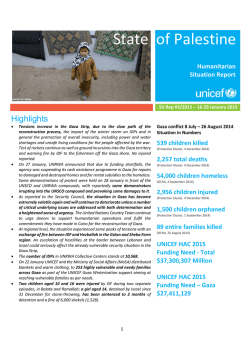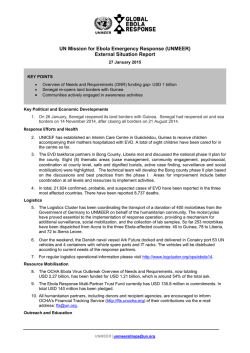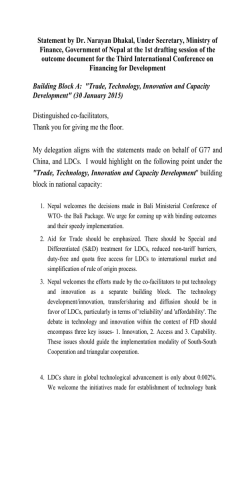
South Asia - ReliefWeb
www.unicef.org/appeals/rosa ©. UNICEF ROSA/2014-0122 Humanitarian Action for Children South Asia South Asia is one of the most disaster-prone and conflict-affected regions in the world, with Afghanistan and India belonging to the top ten countries with the highest number of reported natural disasters in a year1. The most common disasters in the region are floods, drought, landslides, avalanches and earthquakes. In 2014 alone, 4.5 million people were affected by floods in Pakistan-administered Kashmir, Punjab and Sindh, and 2.9 million were affected by drought in Sindh2; 130,000 people were affected by floods in the Far-Western and MidWestern regions of Nepal3; and in in India, 450,000 people were affected by the floods in Uttar Pradesh, 2.6 million in Bihar, 1.2 million in Assam and 5 million in Jammu and Kashmir, apart from 9 million people affected by Cyclone Hudhud in Andhra Pradesh. Sri Lanka, a country that has suffered severe drought and flash floods for the last three years, had 1.5 million people affected by disasters in 2014. In addition, South Asia is also suffering from protracted internationalized and internal armed conflicts and almost half of all terrorist attacks worldwide4. The geographical features of South Asia favor insurgency, while economic and social factors such as poverty, discrimination and poor governance underline grievances that promote separatist movements as well as ideological armed struggles. In 2014, more than 2.6 million people in Pakistan and 630,000 people in Afghanistan were internally displaced due to terrorism, internal conflict and border disputes. The withdrawal of ISAF troops in Afghanistan at the end of the year is seen to have negative implications for the country’s already deteriorating security situation, which will have a direct impact on the conflict dynamics of Pakistan and neighboring countries. Children suffer the most devastating impacts of the conflict, which include separation from families, denial of access to education and health facilities due to their refugee or IDP status, limited availability of food and micronutrients, and being exposed to harsh climate conditions due to poor shelter. In addition to the psychological and emotional impact of conflict on children, their current living conditions due to displacement are making them more vulnerable to disasters from natural hazards such as floods and droughts. Overall, the disaster trends and conflict dynamics in the region tend to cross borders, creating a sub-regional impact, which calls for the Regional Office for South Asia to develop a more strategic approach for assistance and collaboration – not only at the country interagency level but also at sub-regional and regional levels. Regional Office 2015 Planned Results: For 2015 the Regional Office for South Asia will follow up the action plan from last year’s Global Resilience Workshop by initiating activities that aim to build the resilience of communities, especially those most vulnerable to the devastating impacts of conflict and disasters. Under resilience-building, organizational and interagency capacities for risk-informed programming underlined with conflict sensitivity and disaster risk reduction (DRR) will be strengthened. At the policy level, a regional strategy for coping with transnational disasters will be developed with SAARC, as well as the facilitation of policy dialogues pertaining to children and DRR, and Children in a Changing Climate. Furthermore, ROSA is seen to respond to improving emergency preparedness and response through continuous training of staff and management in the country offices, as well as support performance monitoring in humanitarian situations to ensure that commitments and benchmarks as stipulated in the CCCs are adhered to, both by UNICEF and its partners. For this year, ROSA aims to have: At least 40 UNICEF staff and emergency focal points from 8 country offices trained in the use and application of interagency needs assessment tools, and at least 20 UNICEF staff in the region trained as facilitators in conducting conflict and disaster risk analysis, scenario building and contingency planning. A regional strategy on reduction, mitigation and coping with disasters developed with SAARC. Performance monitoring in humanitarian situations internalized and practiced in Afghanistan, Pakistan, Sri Lanka and Nepal. Increased technical capacity at the regional level to support resilience-building activities in all country offices, as well as resilience task forces and dialogue initiatives on resilience with government partners. 2014 Results: In 2014, the regional office had US$107,268 available to support technical capacity building for regional emergency preparedness and response. In 2014, a global resilience workshop was held, the outcomes of which were used to inform a Global Policy Paper on Resilience. Continuous technical support was provided on the sub-regional contingency planning for the transition in Afghanistan, leading to a strengthened emergency preparedness of the Afghanistan country office. Technical support for capacity building 1 Deberati Guha-Sapir, Philippe Hoyois and Regina Below. Annual Disaster Statistical Review 2013. Brussels: Centre for Research on the Epidemiology of Disasters, 2013. 2 Pakistan 2015 Humanitarian Needs Overview 3 Nepal Ministry of Home Affairs and Nepal Red Cross Society, 27 August 2014 Situation Updates on Floods 4 Country Reports on Terrorism 2013, US Department of State - http://www.state.gov/j/ct/rls/crt/2013/index.htm accessed 13 November 2014. www.unicef.org/appeals/rosa on emergency preparedness and response was provided to UNICEF’s Standby Partners at the global level, as well as guidance on the compilation of lessons learned in emergency response in all zonal offices of Afghanistan. A publication on Child Centered Risk Assessments was produced and was rolled out in Nepal, India and Bangladesh. Technical input was also provided to the initiative on Strengthening Humanitarian Action, improvement of Early Warning Early Action system, and through participation in the Global Reference Group on Risk-Informed Programming. Increased regional capacity on security management contributed to the updating of the BCP in Bangladesh, and additional technical capacity on emergency preparedness enabled ROSA to put in place EVD preparedness plans in all country offices of the region. Nepal 2015 Planned Results: Nepal is highly exposed to multiple hazards such as earthquakes, floods, droughts and landslides. Economic losses are estimated at $253 million annually5 due to disasters. In September 2014, the massive floods and landslides in the Mid-Western and Far Western development regions affected 164,500 people, 42 per cent of which are children6, and most of the internally displaced still has not managed to return to their homes due to destroyed infrastructure and limited access to social services, as well as a lack of economic resources. With this year’s challenges in responding effectively to humanitarian needs on the ground, UNICEF Nepal gives importance to emergency preparedness to meet the CCC benchmarks in four cluster areas (WASH, Education, Nutrition and Child Protection), where the capacity of cluster members in Nepal needs to be strengthened and government-led coordination mechanisms at the national and district levels need to be enhanced. With the frequency of disasters expected to increase in the coming years, preparedness must be accompanied with disaster risk reduction, with an approach that also mitigates and prevents risks while building community resilience. Results for 2015 will include: Increased capacity of at least 1000 district-level and national-level government officials and other stakeholders for disaster preparedness and emergency response. 32,500 school-age children have access to education through safe and secure learning environments that promote protection and well-being of learners. 90,000 people, of which approximately 38,000 are children, have access to sufficient safe drinking water and sanitation facilities, accompanied by hygiene education. 90,000 people are provided with long-lasting insecticide-treated nets, oral rehydration salts and zinc tabs for children under five. 22,500 children aged from 6 to 59 months suffering from SAM and MAM receive therapeutic and supplementary feeding. 32,000 children have safe access to protective spaces, psychosocial and related child protection services. 2014 Results: UNICEF Nepal received a total of US$432,371 funding from CERF to respond to the 2014 floods, which was used to distribute winter clothing to 12,838 children aged 5-18 years in 4 districts of the Midwestern Region, while 20,837 children under 5 years of age from the affected areas benefited from RUTF, F-100, F-75, Resomal, height boards and micronutrient powder, as well as hygiene kits and laundry soaps. Semi-permanent latrines and bathing spaces for women and adolescent girls were installed in IDP camps and a hygiene promotion campaign was undertaken in the affected areas. Pakistan 2015 Planned Results: Khyber Pakhtunkhwa province is host to 1.4 million displaced people from Federally Administered Tribal Areas (FATA) – some live in camps, but most live in host communities with relatives and in rented accommodation. Massive displacement from North Waziristan started following new security operations in June 2014, resulting to 73,627 7 IDP families. Pakistan is also hosting 1.6 million Afghan refugees, which is foreseen to increase after the pull out of ISAF forces from Afghanistan at the end of 2014. UNICEF Pakistan Country Office (PCO) aims to respond to this massive displacement due to conflict and increasing violence; respond to the problem of polio endemic in the country, where the current caseload is 243 cases; and reduce the effects of severe drought and acute malnutrition (17.5 per cent) in Sindh Province. In 2015, UNICEF PCO plans to continue to support humanitarian assistance in coordination with the Government of Pakistan, other United Nations agencies and non-governmental organizations, to respond to the needs of the millions of children and women affected by conflict-related insecurity, drought, recurrent monsoon floods and potential refugee influx from Afghanistan. Programme targets for 2015 are as follows: 712,000 children and women will access life-saving interventions through measles campaigns and child health days. 35,433 children will be targeted for admission to therapeutic feeding programmes for management of SAM cases. 966,800 people (including approximately 483,400 children) will have access to sufficient safe drinking water and sufficient quantity for cooking and maintaining hygiene, access to sanitation facilities and hygiene education. 150,000 children and 45,000 women will have safe access to protective spaces and related services. 220,000 children (45 per cent girls) will access education through safe and secure learning environments that promote protection and well-being of learners. 2014 Results: Up to October 2014, UNICEF supported the provision of measles vaccinations to 117,390 children in the accessible emergency-affected areas of Khyber Pakhtunkhwa and Federally Administered Tribal Areas (FATA). Health response remained limited to IDP camps mainly due to funding constraints. Acute and chronic malnutrition in Pakistan exceeds emergency thresholds. To prevent and respond to high levels of malnutrition, 18,572 children under 5 were admitted to outpatient therapeutic programmes (OTP). To prevent water-related disease outbreaks, UNICEF provided safe drinking water to 417,760 of the nearly 720,000 target population in emergencyaffected areas. In education, UNICEF and its implementing partners supported 41,590 children in accessing education through temporary learning centres and IDP camp schools. Critical education supplies including tents, school-in-a-box, schools bags and training of teachers on improved teaching methods not only supported children who were enrolled in schools before displacement but gave an opportunity to new beginners and those out-of-school children. In addition, through Protective Learning and Community Emergency Services (PLaCES) centres, 49,460 children and their caregivers were reached with protection, psychosocial support and recreation services, as well as life skills education. A total of US$45,133,213 was appealed for in 2014, of which some US$38.5 million was available by mid-November. Overall limited access to affected areas, particularly in the FATA region, and limited funds constrained the full achievement of results. 5 Nepal National Society for Earthquake Technology, 2008 National Emergency Operations Center, Nepal Ministry of Home Affairs, as of 28 October 2014. 7 Pakistan National Registration Database Authority, 2014. 6 www.unicef.org/appeals/rosa 2014 PAKISTAN PROGRAMME TARGETS AND RESULTS NUTRITION Children under 5 with acute malnutrition access appropriate outpatient therapeutic treatment Children under 5 provided with micronutrient supplementation Children and women access support for appropriate infant and young child feeding through community outreach services HEALTH Cluster 2014 Targets Cluster Results UNICEF 2014 Targets UNICEF Results 27,880 18,572 27,880 18,572 325,061 202,847 325,061 202,847 244,800 198,561 244,800 198,561 234,630 117,390 275,000 57,542 Children under 5 immunized for measles Children from 0-69 months and women have access to life saving health interventions through women and health child days WATER, SANITATION AND HYGIENE Emergency-affected population provided with access to safe water as per agreed standards Women, men and children have access to improved sanitation Children and women receive critical WASH-related information to prevent child illness CHILD PROTECTION Children and their caregivers have access to various support through protective learning and community emergency services EDUCATION Emergency-affected children (including adolescents) accessing quality education (including through temporary learning structures) 1,165,000 695,345 720,000 417,760 622,000 614,438 484,800 547,707 873,750 602,413 540,000 425,852 413,886 111,936 152,351 49,460 230,895 53,435 121,609 41,590 Results as of 17 October 2014 unless otherwise noted Sri Lanka 2015 Planned Results: Sri Lanka has been experiencing an increased frequency and intensity of floods and droughts during the last three years. In 2014, a total of 1.5 million people were affected by drought, of which 768,000 were impacted by food insecurity and 60,000 were in need of safe drinking water. Out of 25 districts, 15 are severely affected by drought and there is an immediate need to respond to the dire water shortage situation, as well as the decreasing access to food and other nutritional needs of children and women. In the same year, flash floods led to a landslide in Uva province, where 1,875 people were affected. Many families were displaced and took refuge in schools, leading to disruption in schooling for the local children. Given the recurring nature of these disasters, the planned results for 2015 are: 30,000 people in drought-affected districts accessing a sufficient quantity of safe drinking water in compliance with national standards. 30,000 children in drought-affected districts provided with therapeutic feeding to prevent malnutrition and benefit from improved infant and young child feeding practices. At least 10,000 children affected by floods able to continue their schooling through establishment of temporary learning spaces. 2014 Results: UNICEF Sri Lanka had US$443,422 available emergency funding in 2014. Of this amount US$94,204 from CERF provided life-saving emergency water assistance to 34,303 drought-affected people in Ampara, Mullaitivu, Kilinochchi, Mannar and Monaragala. In addition, through collaboration with the Ministry of Social Services (MoSS) some 300 vulnerable families received cash grants to support livelihood initiatives; 27 social care centres were strengthened through construction works, repair or provision of equipment; and 207 social care staff were trained and provided 5,857 families with assistance/or referrals to appropriate services. In addition some 18 psychosocial workers were supported to conduct awareness programmes on issues related to mental health, child abuse and domestic violence, and some 17,000 people received counselling and psychosocial services. www.unicef.org/appeals/rosa Funding requirements UNICEF is requesting US$55,456,773 for regional- and country-level activities in humanitarian action and disaster risk reduction in 2015. Pakistan will require US$48,841,773 in 2015 to respond to humanitarian needs of girls, boys, women and men due to the rapidly shifting conflict and security contexts in the country. These funds will cover response to the complex emergencies in KP & FATA; the health and nutrition support to drought-affected communities in Sindh; and contingency planning for 2015. Funding requirements also include US$3,415,000 for Nepal to effectively respond to the humanitarian needs of at least 15,000 families/100,000 individuals (42 per cent of which are children) for the 2015 monsoon season, and US$500,000 for Sri Lanka to prepare for the recurrence of floods and drought. Emergency preparedness Emergency response support (pass through funding) Regional Office technical capacity (DRR, conflict analysis and prevention, security) Total Sri Lanka Karin Hulshof Regional Director UNICEF South Asia (ROSA) Tel: +977 1 4417 082 Email: [email protected] 500,000 2,000,000 200,000 2,700,000 Country Offices Nepal For further information please contact: 2015 Requirements (US$) Sectors 2015 Requirements (US$) 3,415,000 500,000 Pakistan 48,841,773 Total 52,756,773 Yasmin Haque Deputy Director, Office of Emergency Programmes (EMOPS) UNICEF, New York Tel: +1 212 326 7150 Email: [email protected] Olav Kjørven Director, Public Partnerships Division (PPD) UNICEF, New York Tel: +1 212 326 7160 Email: [email protected]
© Copyright 2025
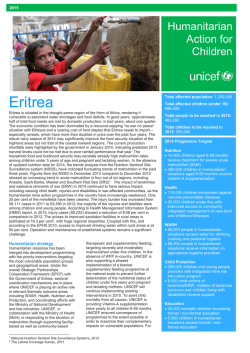
![Current appeal [PDF]](http://s2.esdocs.com/store/data/000476858_1-ff5bfc045afda14d4551c905d8c862b7-250x500.png)
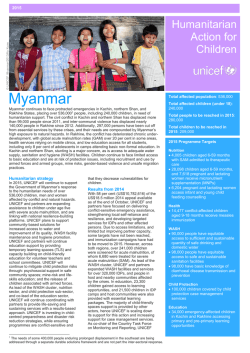
![Current appeal [PDF]](http://s2.esdocs.com/store/data/000470301_1-1a2ac0338c7b87d842a9839e11e746d1-250x500.png)
![Current appeal [PDF]](http://s2.esdocs.com/store/data/000456387_1-84443a4282546a8fcd8c29f2bdd10a65-250x500.png)
